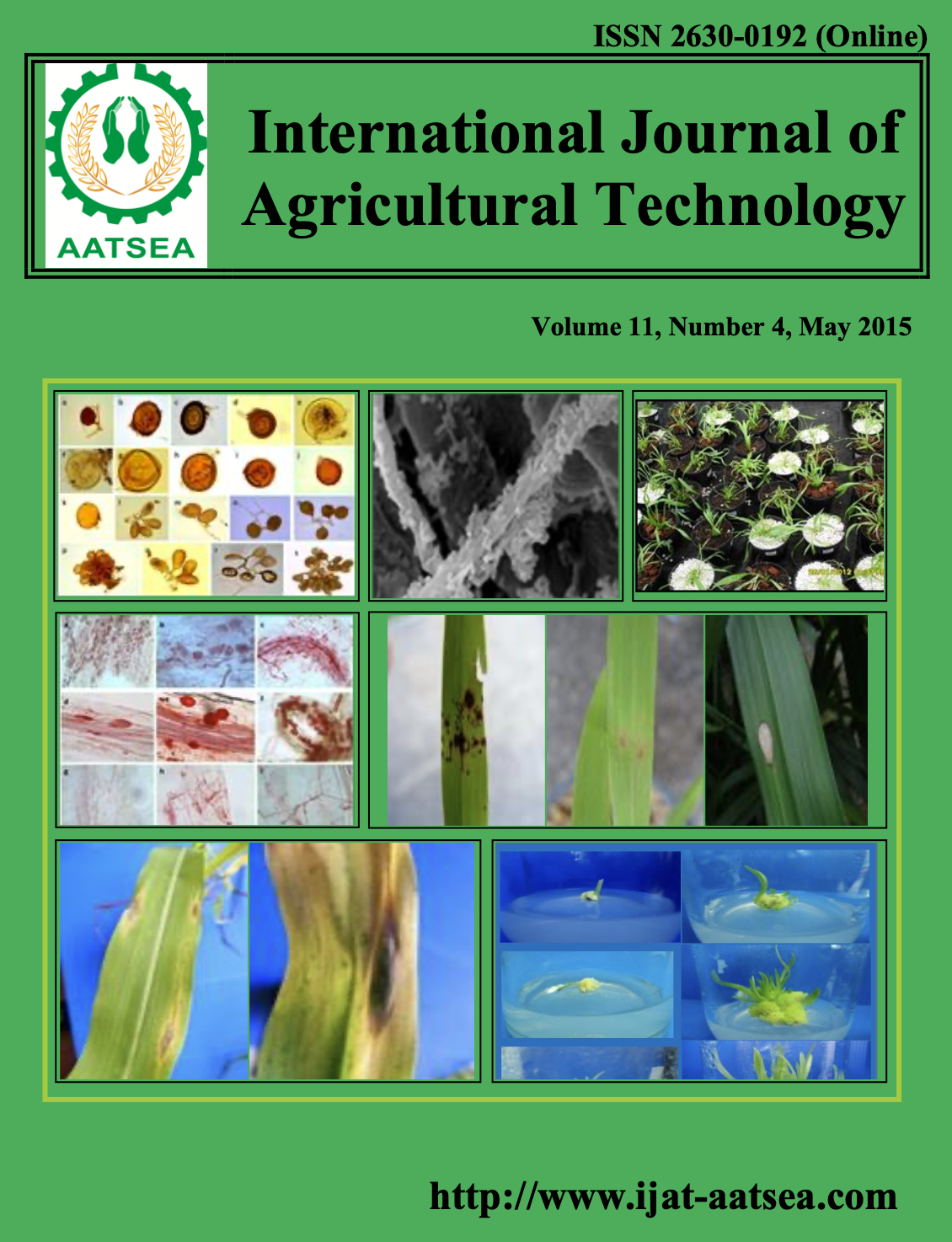Diversity and species composition of arbuscular mycorrhizal fungi in Citrus species
Main Article Content
Abstract
Article Details

This work is licensed under a Creative Commons Attribution-NonCommercial-NoDerivatives 4.0 International License.
References
Allen, S. E., Grimshaw, H. M., Parkinson, J. A. and Quaramby, C. (1974). Chemical analysis of ecological materials. Oxford: Blackwell Scientific Publications.
Anderson, J. M. and Ingram, J. S. I. (1993). Tropical soil biology and fertility: a handbook of methods. Oxford: CAB International.
Anonymous (2002). Indian horticultural database. In National Horticultural Board (Ed.),
Ministry of Agriculture. Govement of India. 208 pp.
Boddington, C. L. and Dodd, J. C. (2000). The effect of agricultural practices on the development of indigenous arbuscular mycorrhizal fungi. I. Field studies in an Indonesian ultisol. Plant and Soil 218:137-144.
Brundrett, M. C., Abbott, L. K. and Jasper, D. A. (1999). Glomalean mycorrhizal fungi from tropical Australia I. Comparison of the effectiveness and specificity of different isolation procedures. Mycorrhiza 8:305-314.
Camprubí, A. and Calvet, C. (1996). Isolation and screening of mycorrhizal fungi from Citrus nurseries and orchards and inoculation studies. Hortscience 31:366-369.
Dandan, Z. and Zhiwei, Z. (2007). Biodiversity of arbuscular mycorrhizal fungi in the hot-dry valley of the Jinsha river, southwest China. Applied Soil Ecology 37:118-128.
Espeleta J. F., Eissenstat D. M. and Graham J. H. (1999). Citrus root responses to localized drying soil: A new approach to studying mycorrhizal effects on the roots of mature trees. Plant and Soil 206:1-10.
Graham, J. H. and Lindermann, D. (1986). Inoculation of Citrus with root fragments containing chlamydospores of the mycorrhizal fungus Glomus intraradices. Canadian Journal of Botany 64:1739-1744.
Graham, J. H. and Syvertsen, J. P. (1985). Host determinants of mycorrhizal dependency of Citrus rootstock seedlings. New Phytologist 101:667-676.
Jumpponen, A. and Trappe, J. M. (1998). Dark septate endophytes: a review of facultative biotrophic root-colonizing fungi. New Phytologist 140:295-310.
Klironomos, J. N. and Hart, M. M. (2002). Colonization of roots by arbuscular mycorrhizal fungi using different sources of inoculum. Mycorrhiza 12:181-184.
Koide, R. T. and Mosse, B. (2004). A history of research on arbuscular mycorrhiza. Mycorrhiza 14:145-163.
Land, S. and Schönbeck, F. (1991). Influence of different soil types on abundance and seasonal dynamics of vesicular arbuscular mycorrhizal fungi in arable soils of North Germany. Mycorrhiza 1:39-44.
Li, H., Smith, S. E., Holloway, R. E., Zhu, Y. and Smith, F. A. (2006). Arbuscular mycorrhizal fungi contribute to phosphorous uptake by wheat grown in a phosphorous-fixing soil even in the absence of positive growth responses. New Phytologist 172:536-543.
Malik, S. K., Chaudhury, R., Dhariwal, O. P. and Kalia, R. K. (2006). Collection and characterization of Citrus indica Tanaka and C. macroptera Montr.: wild endangered species of northeastern India. Genetic Resources and Crop Evolution 53:1485-1493.
McGonigle, T. P., Miller, M. H., Evans, D. G., Fairchild, G. L. and Swan, J. A. (1990). A new method which gives an objective measure of colonization of roots by vesicular-arbuscular mycorrhizal fungi. New Phytologist 115:495-501.
Oehl, F., Sieverding, E., Ineichen, K., Ris, E. A., Boller, T. and Wiemken, A. (2003). Community structure of arbuscular mycorrhizal fungi at different soil depths in extensively and intensively managed agroecosystems. New Phytologist 165:273-283.
Philips, J. M. and Hayman, D. S. (1970). Improved procedures for clearing roots and staining parasitic and vesicular–arbuscular mycorrhizal fungi. Transactions of the British Mycological Society 55:158-160.
Read, D. J. and Haselwandter, K. (1981). Observation on the mycorrhizal status of some alpine plant communities. New Phytologist 88:341-353.
Sharma, B. D., Hore, D. K. and Gupta, S. G. (2004). Genetic resources of Citrus of north-eastern India and their potential use. Genetic Resources and Crop Evolution 51:411-418.
Singh, S., Pandey, A., Chaurasia, B. and Palni, L. M. S. (2008). Diversity of arbuscular mycorrhizal fungi associated with the rhizosphere of tea growing in ‘natural’and ‘cultivated’ ecosites. Biology and Fertility of Soils 44:491-500.
Singh, S., Shivankar, V. J., Gupta, S. G., Singh, I. P., Srivastava, A. K. and Das, A. K. (2006). Citrus in NEH region. Nagpur, Maharashtra, India: National Research Centre for Citrus Publication. pp. 1-179.
Smith, S. E. and Read, D. J. (1997). Mycorrhizal symbiosis 2nd edition. San Diego, CA, USA.: Academic Press.
Uma, E., Muthukumar, T., Sathiyadash, K. and Muniappan, V. (2010). Mycorrhizal and dark septate fungal associations in gingers and spiral gingers. Botany 88:500-511.
Yago, J. I., Sison, J. M., Mateo, S. G., Rivera, K. B., Gonzales, M. P. and Bustamante, E. I. (2009). Diversity studies and utilization of indigenous vesicular- arbuscular mycorrhizal fungi isolated from Citrus plantations.


